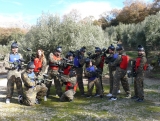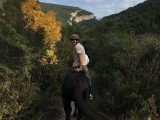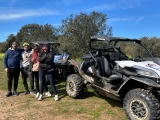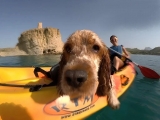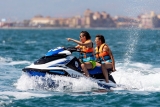Once you’ve figured all this out, the next step is deciding how you’ll do it. Here are the different ways to complete the Camino de Santiago.
1. On Foot
This option isn’t particularly original, as it’s the most popular choice among pilgrims, but if you’re considering it, we encourage you to go for it. Just make sure to follow the advice in our article on essential tips for the Camino, paying special attention to the section on footwear. It’s the most important thing if you choose this option.

2. By Bike
Another common choice. Here, you’ll need to focus not just on your backpack but also on preparing a special kit for your bike. Why? Because it might break down during the journey, and you’ll need the right tools to fix it: Allen keys, screwdrivers, patches, spare inner tubes, and a pump. Check out this dedicated article on the topic.
As for clothing, remember it should be tight-fitting to avoid wind resistance and bright-coloured so drivers can easily spot you.

And as a recommendation, if you’re in a group, make sure everyone rides single file to avoid blocking the path and allow other walkers or drivers (if on roads) to pass comfortably.
3. On Horseback
This option is reserved for those with prior horse-riding experience and who are accustomed to long journeys on horseback. Otherwise, it could lead to discomfort or dissatisfaction.
When planning your trip, compile a list of places where your horse can stay overnight, as well as nearby vets along the route. It’s also essential to insure the animal.

Just as you’d prepare gear for a bike, you’ll need to pack everything your horse might need: food, water, proper equipment for both of you, a first-aid kit, and a transport vehicle. After each stage, check the horse’s hooves, legs for swelling, etc. Here’s all the necessary information.
4. By Motorbike
The most important thing here is ensuring your vehicle is in top condition: tyres, brakes, oil, lights... Take it to a garage for a thorough check-up to avoid any mishaps.
When packing, don’t forget protective gear—cover your entire body, especially delicate areas like elbows and back. Knee pads are highly recommended, and gloves are a must!

The French Way is one of the most popular routes, but with a motorbike, you can start from any point—all are equally valid and interesting.
5. On a Skateboard
Yes, you read that right. A few years ago, news broke of two Basque friends completing the Camino on longboards (special long skateboards) designed for the feat. Since then, many skaters have opted for longboards or freeride skates, which handle varied terrain beyond just asphalt.
It’s a great alternative for something different, especially if you’re passionate about the sport. Just note that flat sections and downhill runs will need to alternate with uphill walks or dirt paths where you’ll have to carry the board.

Don’t forget a helmet, knee and elbow pads to prevent injuries, and spare trainers in case the braking foot wears out.
6. By Campervan
A very comfortable option, especially during peak seasons when hostels are overcrowded. Plus, it gives you the freedom to bring your own food, cook, and is ideal if travelling with children.
When planning your route, research designated campervan areas, often near recreational spots with picnic areas for breaks.

You can combine campervan travel with stretches on foot to stretch your legs and enjoy the scenery—it’s worth it, no matter which route you choose.
7. By Kayak
Yes, really. Some companies organise trips to do the Camino de Santiago by kayak, though only certain sections are navigable. It’s a unique way to experience the journey, perfect for combining sport and nature.
One option, for example, is paddling through the Ría de Arousa, skirting Cortegada Island and spotting islets. You can also descend the River Ulla to its mouth near Padrón. From there, continue on foot via the Portuguese Way to Santiago.

If you choose this option, pack swimwear, sunscreen, waterproof footwear, and a towel.
*Note: Any method other than walking, cycling, or horseback must use alternative routes to avoid disrupting pilgrims on the main path.





